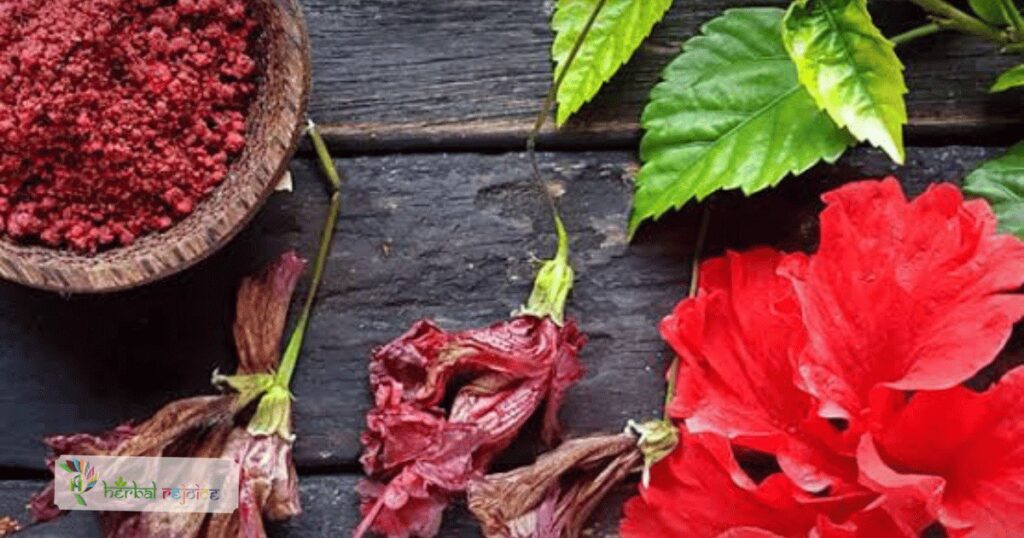Introduction:
Hibiscus rosa-sinensis Linn., also known as Rose-of-China or Shoeflower, is a plant native to China but widely grown in gardens throughout India.
Belonging to the Malvaceae family, this plant has been used in traditional systems of medicine such as Ayurveda, Unani, and Siddha/Tamil for its various health benefits.
Hibiscus is rich in antioxidants and it promotes weight loss, reduce the growth of bacteria and cancer cells, and support the health of the heart and liver.
In this article, we will explore the medicinal properties and uses of Hibiscus rosa-sinensis Linn., along with its active compounds and dosage recommendations.
Names And Habitat Of Hibiscus
Hibiscus syriacus Linn. (Rose of Sharon or Shrubby Althaea) is often equated with the white-flowered variety of Hibiscus rosa-sinensis Linn. cultivated in gardens throughout India.
The white flowers of Hibiscus syriacus Linn. have been used as a demulcent and antidiarrheal agent.
The bud of this variety yields mucilage, primarily composed of partially acetylated acidic polysaccharides.
Medicinal Uses Of Hibiscus
1. Impotency and Bronchial Catarrh:
The flowers of Hibiscus rosa-sinensis Linn. are used traditionally to treat impotency and bronchial catarrh. Their therapeutic effects in these conditions have been observed and documented.
2. Emmenagogue:
Both the flowers and bark of Hibiscus rosa-sinensis Linn. have emmenagogue properties, meaning they can stimulate and promote menstrual flow. This can be beneficial for women experiencing irregular or delayed menstruation.
3. Expulsion of Placenta after Childbirth:
The leaves of Hibiscus rosa-sinensis Linn. are known to stimulate the expulsion of the placenta after childbirth. This property can aid in a smooth delivery and postpartum recovery.
4. Laxative and Anodyne:
The leaves of Hibiscus rosa-sinensis Linn. have a laxative effect, promoting bowel movements and relieving constipation. They also possess anodyne properties, providing pain relief.
5. Menorrhagia:
The flowers and roots of Hibiscus rosa-sinensis Linn. have been used in the treatment of menorrhagia, a condition characterized by heavy or prolonged menstrual bleeding.

Active Compounds Of Hibiscus
Hibiscus rosa-sinensis Linn. contains various active compounds that contribute to its medicinal properties. These include cyclopropanoids such as methyl sterculate, methyl2-hydroxysterculate, 2-hydroxysterculate, malvalate, and beta-sitosterol.
The major anthocyanin present in the flower is cyanidin 3-sophoroside. The flower nectar is rich in amino acids, particularly aspartic acid and asparagine. The concentration of amino acids increases during pollination.
Health Benefits Of Hibiscus
1. Anti-Inflammatory Activity:
A study conducted on male albino rats showed that the flower powder of Hibiscus rosa-sinensis Linn. exhibited anti-inflammatory activity, reducing rat paw edema induced by carrageenan.
2. Antitumor Activity:
The aqueous extract of Hibiscus rosa-sinensis Linn. has shown antitumor activity against sarcoma 180 ascites cells. This indicates its potential in the treatment of certain types of cancer.
3. Regulation of Estrus Cycle:
An aqueous extract of the flowers of Hibiscus rosa-sinensis Linn. was found to reduce the duration of the estrus cycle in experimental albino rabbits. This suggests its potential for regulating reproductive processes.
4. Antiimplantation Activity:
The alcoholic extract of the flowers of Hibiscus rosa-sinensis Linn. exhibited antiimplantation activity, indicating its potential as a contraceptive agent.
5. Effects on Spermatogenesis and Endocrine Function:
Oral administration of a flower extract of Hibiscus rosa-sinensis Linn. to rats affected spermatogenesis and endocrine function of the testis. This suggests a potential role in male reproductive health.
6. Blood Sugar Regulation:
In diabetic patients, a flower bud of Hibiscus rosa-sinensis Linn. is given daily for up to 10 days or until the level of blood sugar is reduced to tolerable limits. This indicates its potential in managing diabetes.
Conclusion:
Hibiscus rosa-sinensis Linn., also known as Rose-of-China or Shoeflower, is a plant with significant medicinal properties.
Its flowers, leaves, and roots have been traditionally used in the treatment of various conditions, including impotency, bronchial catarrh, menstrual disorders, and more.
The plant contains active compounds such as cyclopropanoids, anthocyanins, and aminoacids. It exhibits anti-inflammatory, antitumor, and blood sugar-regulating activities, among others.
Overall, Hibiscus rosa-sinensis Linn. is a valuable medicinal plant with numerous health benefits.


